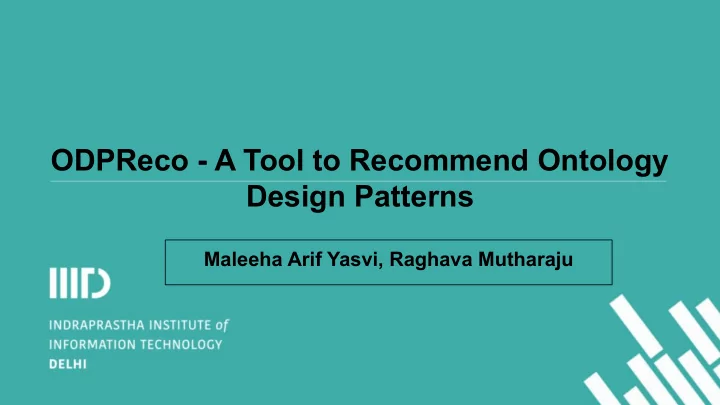

ODPReco - A Tool to Recommend Ontology Design Patterns Maleeha Arif Yasvi, Raghava Mutharaju
CONTENTS ● Ontology Vs ODP ● Why use ODPs in Ontology ● Approach ● Our Dataset ● Ontology Analysis ● Machine Learning on existing ODPs ● Work Done so far ● Conclusion
Ontology VS ODP Ontology is the description of knowledge as a set of concepts and the relationship that holds between them. ODPs are the re-usable patterns that are used to improve quality of an ontology and make it more modular.
Why use ODP in an Ontology ● Ontologies are non-modular ● Difficult to comprehend ● High maintenance cost
Approach ODPReco analyzes the lexical , structural and behavioural aspects of an ontology and compares it with that of the ODPs in order to recommend an ODP.
DATASET Dataset referred as Collection . It includes: ● ODPs from the ODP repository (220 ODPs) ● MODL: Modular Ontology Design Library
ODP Repository 220 ODPs:
MODL ● Well-Documented ODPs. ● Collection of annotated OWL files with complete description of each pattern.
Ontology Analysis ● Lexical - Description along with the names of classes, properties and individuals of an ontology compared against the collection. ● Behavioural - Competency questions being compared. ● Structural - Axioms being compared
Ontology Analysis ● Combining the scores of three and setting a threshold above which the list of ODPs can be recommended.
Machine Learning on existing ODPs Features considered are: Lexical, Structural and behavioural.
Machine Learning on existing ODPs Some drawbacks with this approach are : ● Training data is limited ● Feature Selection is cumbersome ● Prediction might not be accurate
Work Done so far Lexical Analysis: Description of Ontology Stop Word Removal Comparing with ODP by implementing Doc2Vec Obtaining the similarity
Lexical Analysis Extracting the signature:: Signature of Ontology using OWL api IRI Removal Comparing with ODP signature using Doc2Vec Obtaining the Similarity
Work Done so Far Behavioural Analysis: Competency Questions of Ontology Stop Word Removal Comparing with ODP by implementing Doc2Vec Obtaining the similarity
Work Done so Far Structural Analysis: Axioms of Ontology using the OWL api IRI Removal Comparing with ODP by implementing Doc2Vec Obtaining the similarity
Conclusion Using this tool, ODPs can be recommended for bulk ontologies and hence, can help in improving the quality of the ontology.
Questions to the community 1. Are there a set of ontologies that have the “before applying ODPs” and “after applying ODPs” versions? 2. Apart from the three features that are discussed, are there any other aspects that could be used as features in the ML algorithm? 3. Apart from user study, are there any other mechanisms to validate this tool? 4. What other features would you like to see in this tool?
THANK YOU maleeha18112@iiitd.ac.in raghava.mutharaju@iiitd.ac.in
Recommend
More recommend